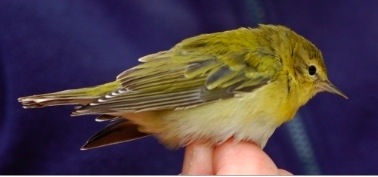 For the last week, a butt load of butter butts (aka yellow-rumped warblers) have descended on my neighborhood. They are fueling up before they head south and they are an end of the warbler migration. You may have heard them in your neighborhood, their migration call chip note sounds a bit like a kiss.
For the last week, a butt load of butter butts (aka yellow-rumped warblers) have descended on my neighborhood. They are fueling up before they head south and they are an end of the warbler migration. You may have heard them in your neighborhood, their migration call chip note sounds a bit like a kiss.

This morning, one flew right up to my window screen. Of course this happened just as I sat down to coffee at my computer, my camera was in the kitchen and my cell phone was charging...how to get a photo? I supposed it wouldn't have made a difference because all I could see was the tail on the screen and periodically a tiny bill going for some tiny insect that hangs out on our window screens this time of year. Eventually, it flew to a wire outside the screen and a little bit of pishing kept it in one spot for enough time for me to digiscope a few photos.
 The yellow-rumps were covering trees, stucco walls and windows for bugs to build up their fat stores for migration.
The yellow-rumps were covering trees, stucco walls and windows for bugs to build up their fat stores for migration.

Though I was unable to get a shot of the yellow-rumped warbler on my window screen, I was able to get one gleaning insects off of my neighbor's window. At this point, I did wonder if any of my neighbors noticed the big scope out of my kitchen window--really, I'm taking photos of birds. Honest.

After the yellow-rumped moved on, a young house sparrow flew up. One of the things that makes house sparrows so adaptable is their ability to find food. I've watched them watch chickadees when I add a new feeder. They seem to study how the chickadees land and find food and after a day (or a few hours) give it a shot themselves. The house sparrows watched all the warblers in the trees and clinging to buildings in my neighborhood and then would flutter in the same spots the warblers had been looking for food. The above bird hung out on the corner, searched the frame and then continued to watch the surrounding warblers, it was almost as you could see the thought bubble, "How are these guys finding food, I don't see what they're after."

Ah, yellow-rumps, I love them but they are the sign that migration will soon be winding to a close and winter will be in full throttle. Enjoy them while they last.

 One of the things I was counting on to give me an edge over Clay in our
One of the things I was counting on to give me an edge over Clay in our 









